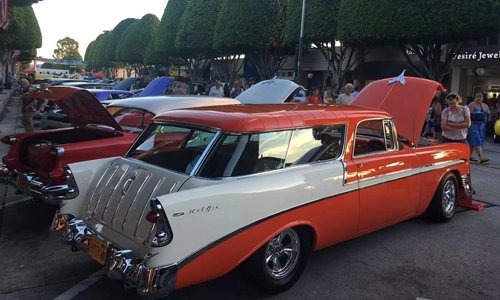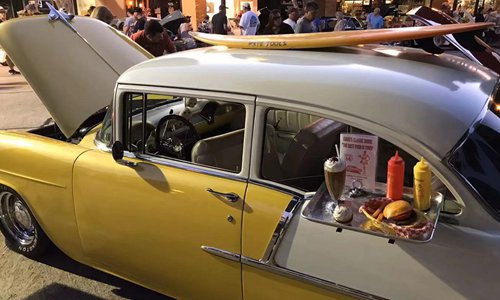HOME >> WORLD
Antique cars highlighted in US auto shows
By Zi Zhuo and Elaine Yue Lin Source:Global Times Published: 2019/10/31 21:18:42
A treasure that has never faded from American life

US Antique cars Photo: Zi Zhuo

US Antique cars Photo: Zi Zhuo
Autumn is the busiest time of year for American car shows. Many small towns host shows that feature a variety of antique cars. No matter where they come from, each car carries a history of American life. Whether you are an expert or a layman, you will always sense a strong nostalgia.
Antique cars are often part of significant parades and anniversaries, as well as traditional festivals.
The oldest cars in US museums can be traced back to the 1890s, while most antique cars displayed at auto shows were built between the 1930s and 1950s.
The auto industry had its birth in the US in the 1920s. A car was a luxury at that time. Automakers, like GM (Chevrolet and Cadillac), Ford (Model-T, Intercontinental), Chrysler (Jeep), as well as the rare German imported Volkswagen, tried hard to make every detail unique. Back then, a car was not only a form of transportation, but also a symbol of the owner's wealth, identity and living standard.
As a result of the baby boom after World War II, the youth population of the US reached its peak in the 1960s. The number of drivers soared, leading to the second phase of the US auto industry.
Different from their parents, those teenagers valued speed and power instead of luxury and classic styles. As a result, American auto designers focused on dynamics and modernism. As an example, the first Mustang made by Ford in 1964 has become hotly sought after by many enthusiasts.
In the 1980s, urban life became more suburban in the US, and consequently auto designs developed along more practical and multi-functional lines. Starting with the first minivan by Chrysler, the market was filled with multi-purpose off-road vehicles and small pickup trucks. Gradually disappearing from roads, antique cars became a precious memory in enthusiasts' garages.
American antique cars have been handed down from generation to generation and almost every one of them has a story.
Rob, who lives in West Covina, California, recalled that his parents spent $650 on a second-hand 1964 Chevrolet for his high school graduation. It was his first car. The owner used to be his classmate at middle school, who joined the army and later served in Vietnam.
"I remember my parents were paying it off in installments at first," said Rob. But after the first payment, they heard that his classmate would never come home. Rob's eyes were bleak while reflecting on this. Soon afterwards, his parents paid it off in full to his classmate's mother.
He has had that car for more than five decades. The first girl he invited to ride in it later became his wife. Since retiring, Rob has spent a lot of money on restoring the half-century-old vehicle. For him, it is a must-display at every auto show.
Jenny, who graduated from Glendora High School 15 years ago, cherishes the first Chevrolet her parents bought for her.
"I fell in love with it at first sight when I saw the car in my neighbor's garage." She persuaded her parents to buy the car for $4,000. Then she became the most popular girl off campus.
American antique cars mostly are not super expensive and for enthusiasts, their love of those cars is priceless.
Barry Miller, who works in a supermarket, spent all his savings of $10,000 buying a 1950s Chevrolet many years ago. Afterwards, he spent another $35,000 and countless hours and energy transforming it into a special edition for collection.
"Only those with the same enthusiasm know why," he said.
Route 66, known as "the Mother Road of the US," is the home base of American antique cars. Still today, many cities and communities along the way retain the tradition of antique car gatherings every Sunday afternoon. Many cities also host an annual midsummer nostalgia festival to showcase antique cars from all over the country.
The owners of antique cars are nostalgic and traditional. Many of them inherited their cars from their fathers and they spend almost their entire lives at the same place from childhood to adulthood, said the owner of an antique car dealer on Route 66.
Just like an amber of an era, antique cars are covered with an indelible glittering imprint.
Posted in: MORE NEWS